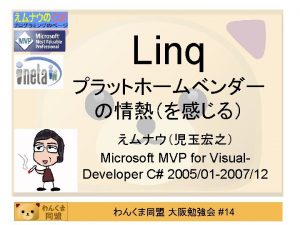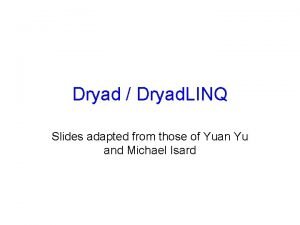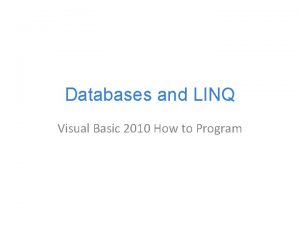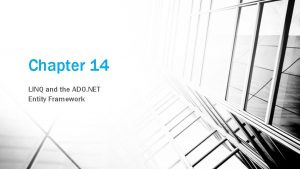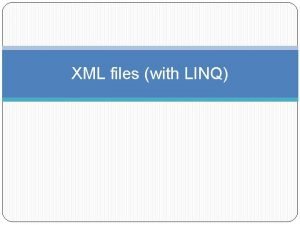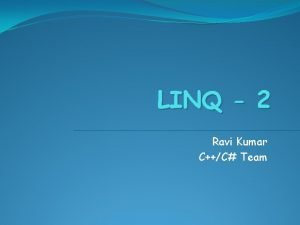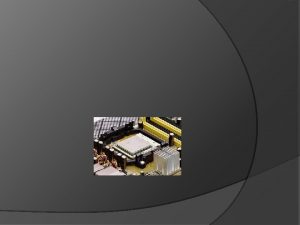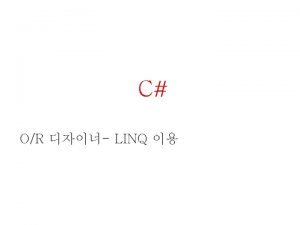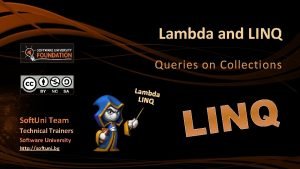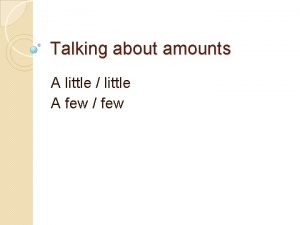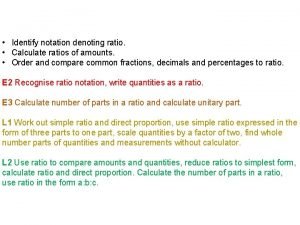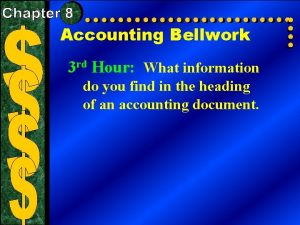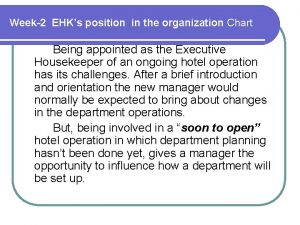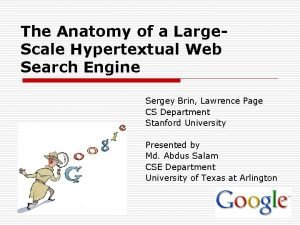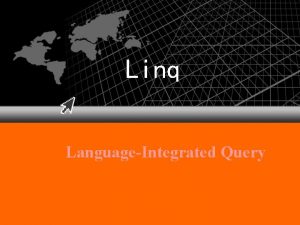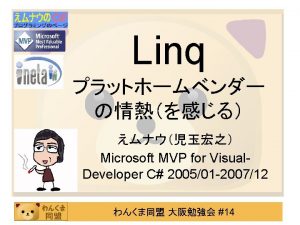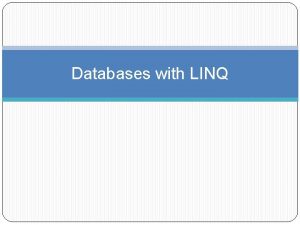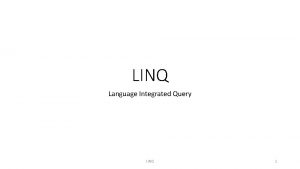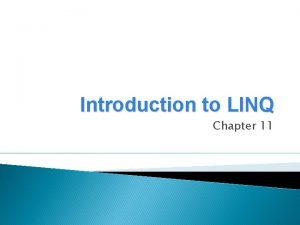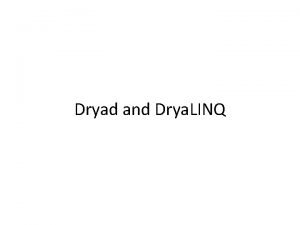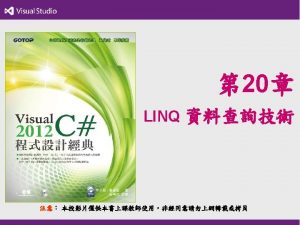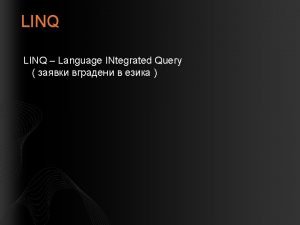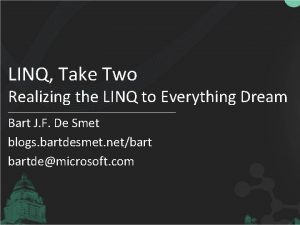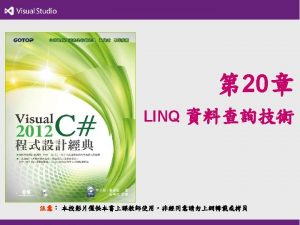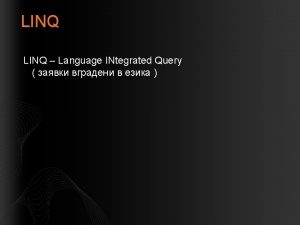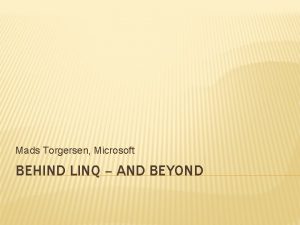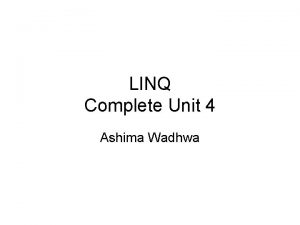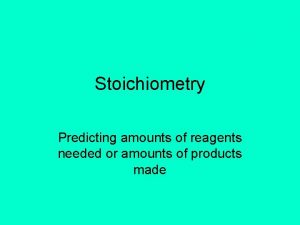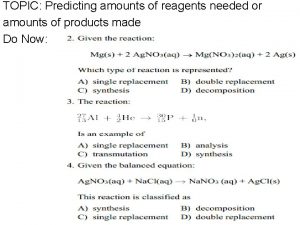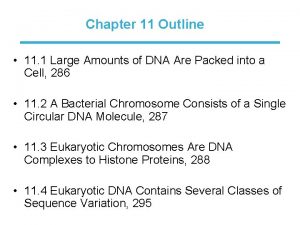Introduction to LINQ Chapter 11 Introduction Large amounts




























- Slides: 28

Introduction to LINQ Chapter 11

Introduction • Large amounts of data are often stored in a database—an organized collection of data. • A database management system (DBMS) provides mechanisms for storing, organizing, retrieving and modifying data contained in the database. • Today’s most popular database systems are relational databases. • A language called Structured Query Language (SQL) is an international standard used with relational databases to perform queries (that is, to request information that satisfies given criteria) and to manipulate data. © 1992 -2011 by Pearson Education, Inc. All Rights Reserved.

Introduction • For years, programs that accessed a relational database passed SQL queries as Strings to the database management system then processed the results. • Microsoft developed LINQ (Language Integrated Query) to enable you to write query expressions similar to SQL queries that retrieve information from a wide variety of data sources—not just relational databases—using a common syntax that is built into Visual Basic. © 1992 -2011 by Pearson Education, Inc. All Rights Reserved.

Introduction • We use LINQ to Objects to query the contents of arrays, selecting elements that satisfy a set of conditions—this is known as filtering. • We also use LINQ to Objects to perform common array manipulations such as sorting an array. • Figure 11. 1 shows the types of LINQ queries. © 1992 -2011 by Pearson Education, Inc. All Rights Reserved.

© 1992 -2011 by Pearson Education, Inc. All Rights Reserved.

Querying an Array of Primitive-Type Elements Using LINQ • Primitive types are the basic type of data – Byte, short, int, long, float, double, boolean, char – Primitive variables store primitive values. • LINQ allows you to look at collections of data, extract information and manipulate data. © 1992 -2011 by Pearson Education, Inc. All Rights Reserved.

Querying an Array of Primitive-Type Elements Using LINQ • Example: Dim values() As Integer = {2, 9, 5, 0, 3, 7, 1, 4, 8, 6} Dim filtered = From value In values where (value > 4) Select value © 1992 -2011 by Pearson Education, Inc. All Rights Reserved.

Querying an Array of Primitive-Type Elements Using LINQ • Our first LINQ query begins with a From clause which specifies a range variable (value) and the data source to query (the array values). • The range variable represents each item in the data source, much like the control variable in a For Each…Next statement. • If the condition in the Where clause evaluates to True, the element is selected—that is, it’s included in the collection of Integers that represents the query results. • Here, the Integers in the array are included only if they’re greater than 4. © 1992 -2011 by Pearson Education, Inc. All Rights Reserved.

Querying an Array of Primitive-Type Elements Using LINQ • For each item in the data source, the Select clause determines what value appears in the results. • In this case, it’s the Integer that the range variable currently represents. • The Select clause is usually placed at the end of the query for clarity, though it may be placed after the From clause and before other clauses, or omitted. • If omitted, the range variable is implicitly selected. • The Select clause can transform the selected items—for example, Select value * 2 in this example would have multiplied each selected value in the result by 2. © 1992 -2011 by Pearson Education, Inc. All Rights Reserved.

Querying an Array of Primitive-Type Elements Using LINQ • You can use a For Each…Next statement to iterate over the results of any LINQ query. © 1992 -2011 by Pearson Education, Inc. All Rights Reserved.

Querying an Array of Primitive-Type Elements Using LINQ • Sorting LINQ Query Results – The LINQ query in the above example selects the elements of the array values and returns an IEnumerable object containing a sorted copy of the elements. Dim values() As Integer = {2, 9, 5, 0, 3, 7, 1, 4, 8, 6} Dim sorted = From value In values Order By value Select value © 1992 -2011 by Pearson Education, Inc. All Rights Reserved.

Querying an Array of Primitive-Type Elements Using LINQ • The Order By clause sorts the query results in ascending order. • You can use the Descending modifier in the Order By clause to sort query results in descending order. • An Ascending modifier also exists but is rarely used, because it’s the default. • You can use the Order By clause only for values that can be compared to one another. • The Order By clause supports values of any type that implements the interface IComparable, such as the primitive numeric types and String. • Such types provide a Compare. To method.

Querying an Array of Reference-Type Elements Using LINQ is not limited to querying arrays of primitive types. It can be used with most data types.

Example

Example

Example

Example

Example

Example

Example

Querying an Array of Reference-Type Elements Using LINQ When you type the name of an IEnumerable object (such as an array or the result of a LINQ query) then type the dot (. ) separator, the list of the methods and properties that can be used with that object are shown. Some of the methods are so-called extension methods. For example, if you have an array of Doubles called numbers and you want to calculate the average of its values, you can simply call the Average extension method, as in numbers. Average(). Some of IEnumerable’s 45 extension methods are shown in Fig. 11. 5.


Creating Objects of Anonymous Types ◦ Example: Dim names= From Employee In employees Select Employee. first. Name, Employee. last. Name

Creating Objects of Anonymous Types The LINQ query in this example selects only the First. Name and Last. Name from each Employee object. You can select portions of matching objects by specifying the properties to select in a comma-separated list. Only the selected instance can be accessed when iterating over the query results. When you select a portion of an object’s instance, the compiler creates a new class containing those instance—First. Name and Last. Name in this example—and the methods that are inherited by all classes from class Object The new class does not have a name and cannot be used by you to create new objects—such classes are called anonymous types.

Deferred Execution and Transforming Query Results • LINQ uses a technique called deferred execution —a query executes only when you iterate over the results, not when the query is defined. • This allows you to create a query once and execute it many times. • If you make any changes to the data in a LINQ query’s data source, the next time you iterate over the query’s results, the query will process the current data in the data source. © 1992 -2011 by Pearson Education, Inc. All Rights Reserved.

Deferred Execution and Transforming Query Results • Figure 11. 7 filters an array of Strings by searching for those that begin with "r". • Initially the array (lines 8– 9) contains two such Strings. • Later in the program we modify the array then reexecute the LINQ query to demonstrate deferred execution. • This example also demonstrates how to transform the items that match the Where clause—in this case, each matching String is converted to uppercase in the query result. © 1992 -2011 by Pearson Education, Inc. All Rights Reserved.

© 1992 -2011 by Pearson Education, Inc. All Rights Reserved.

© 1992 -2011 by Pearson Education, Inc. All Rights Reserved.
 Vb.net linq
Vb.net linq Linq guernsey
Linq guernsey Medtronic loop recorder lnq11
Medtronic loop recorder lnq11 Linq rank
Linq rank Visual basic linq
Visual basic linq Linq vs ado.net
Linq vs ado.net Linq language
Linq language Linq for c++
Linq for c++ C# linq median
C# linq median Vba linq
Vba linq Reveal linq
Reveal linq Aashima lamba
Aashima lamba Talking about amounts
Talking about amounts Combining ratios calculator
Combining ratios calculator Line/strip search pattern
Line/strip search pattern Problem 8-3 extending amounts across the work sheet
Problem 8-3 extending amounts across the work sheet How to determine if a single replacement reaction occurs
How to determine if a single replacement reaction occurs Calculating customs bond amounts
Calculating customs bond amounts Exploring religions chapter 4 large
Exploring religions chapter 4 large Exploring religions chapter 6 large
Exploring religions chapter 6 large Exploring the religions of our world pdf
Exploring the religions of our world pdf Brand equity starbucks
Brand equity starbucks Ehks
Ehks Linear geography
Linear geography Degrees of comparison of bad
Degrees of comparison of bad Label large intestine
Label large intestine Function of digestive tract
Function of digestive tract The gray-brown haze often found over large cities is called
The gray-brown haze often found over large cities is called The anatomy of a large scale hypertextual web search engine
The anatomy of a large scale hypertextual web search engine
